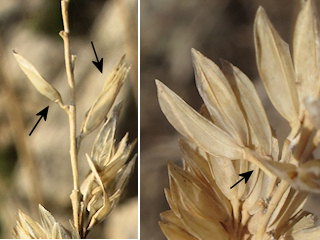| Taxa left beyond this couplet: 7 P. aquaticaP. brachystachysP. canariensisP. coerulescensP. minorP. paradoxaP. truncata Description of Phalaris Annuals or perennials. Leaves flat. Inflorescence an ovoid to cylindrical panicle, usually dense and unlobed. Spikelets strongly compressed laterally, With 2-3 florets, the lower (1-)2 reduced to lemmas, the uppermost hermaphrodite. Glumes subequal, chartaceous, longer than the florets, 3- to 5-veined, often winged on the keel. Lower lemmas small, linear to lanceolate; upper lemma 5-veined, coriaceous. Palea coriaceous.
Description by T. G. Tutin extracted from Flora Europaea Vol 1-5
(Tutin et al., 1964-1993) |

